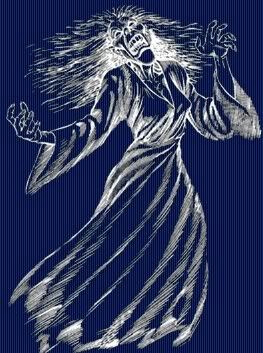Post by bluefedish on Dec 11, 2007 13:33:30 GMT -5
Also called Banshi, Benshee, & Bean-nighe.
An Irish supernatural being of the wraith type which according to legend, attaches itself to certain ancient families and is regularly seen or heard before the death of one of its members.
The word Banshee is supposed to be derived from the Old Irish 'ben sidhe', a woman of the fairy folk or 'woman of the fairy mound', but it's translated by different scholars in a variety of ways, including Female Fairy, Angel of Death, Lady of Death, Woman of Peace, White Lady of Sorrow, Nymph of the Air, and Spirit of the Air, etc.
The Banshee is not limited to Ireland, since she is also the subject of folktales in the highlands of Scotland, where she is know as Bean-nighe or 'little-washer-by-the-ford'. She is said to be seen by the side of a river, washing the blood from the clothes of those who will die. The name is sometimes also used to denote a sort of demon, but in Nordic folklore the Banshee is always benevolent.
Banshees are frequently described as dressed in white or grey, and often having long, fair hair which they brush with a silver comb, a detail scholar Patricia Lysaght attributes to confusion with local mermaid myths. This comb detail is also related to the centuries-old traditional romantic Irish story that, if you ever see a comb lying on the ground in Ireland, you must never pick it up, or the banshees (or mermaids - stories vary), having placed it there to lure unsuspecting humans, will spirit such gullible humans away. Other stories portray banshees as dressed in green, red or black with a grey cloak.

Selected Sources:
www.occultopedia.com/b/banshee.htm
en.wikipedia.org/wiki/Banshee
www.legendsofamerica.com
An Irish supernatural being of the wraith type which according to legend, attaches itself to certain ancient families and is regularly seen or heard before the death of one of its members.
The word Banshee is supposed to be derived from the Old Irish 'ben sidhe', a woman of the fairy folk or 'woman of the fairy mound', but it's translated by different scholars in a variety of ways, including Female Fairy, Angel of Death, Lady of Death, Woman of Peace, White Lady of Sorrow, Nymph of the Air, and Spirit of the Air, etc.
The Banshee is not limited to Ireland, since she is also the subject of folktales in the highlands of Scotland, where she is know as Bean-nighe or 'little-washer-by-the-ford'. She is said to be seen by the side of a river, washing the blood from the clothes of those who will die. The name is sometimes also used to denote a sort of demon, but in Nordic folklore the Banshee is always benevolent.
Banshees are frequently described as dressed in white or grey, and often having long, fair hair which they brush with a silver comb, a detail scholar Patricia Lysaght attributes to confusion with local mermaid myths. This comb detail is also related to the centuries-old traditional romantic Irish story that, if you ever see a comb lying on the ground in Ireland, you must never pick it up, or the banshees (or mermaids - stories vary), having placed it there to lure unsuspecting humans, will spirit such gullible humans away. Other stories portray banshees as dressed in green, red or black with a grey cloak.

Selected Sources:
www.occultopedia.com/b/banshee.htm
en.wikipedia.org/wiki/Banshee
www.legendsofamerica.com



